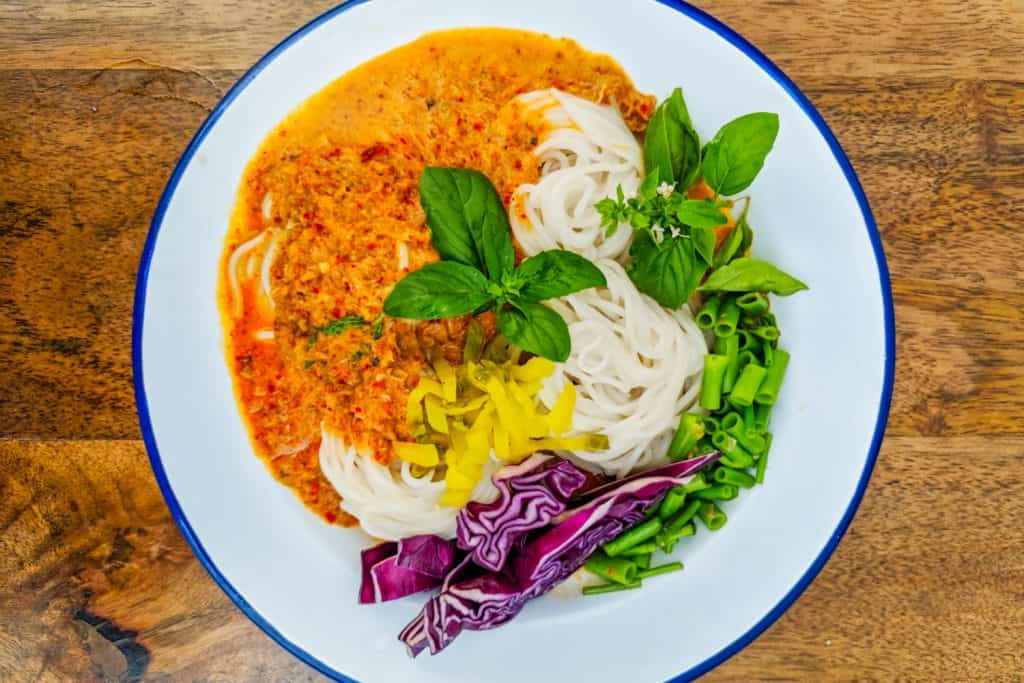In Thailand noodles are mainly featured in fried dishes (the ubiquitous pad thai, for instance), and curries are almost always eaten with rice. This street dish is the exception, where kanom jeen noodles are served with one of a selection of different curries and any number of condiments to suit personal taste. It's a cheap dish, not generally huge in portion size, usually costing a more than reasonable 20-30 baht (in the ballpark of 50p), and is well worth seeking out.
I recently spent a few days in Bangkok, a once hated city which has grown on me in ways reminiscent of disordered teenage crushes (ohmygod I-like-you-so-much-we'll-be-together-forever-let's-have-babies-and-save-the-world). It's a city of food, pure and simple. It was made to be eaten, and that's precisely what captured my interest and drew me into this urban love affair (I-can't-stop-thinking-about-you-do-you-love-me).
I set out early one morning to have breakfast at a vegetarian food court near Chatuchak market. Alas, it was Monday, the one day a week the restaurant is closed. Crushed (but not overly so as the adjoining shop remained open and I found some vegan treats), I was directed by a local to another vegetarian stall down the road. This was my first experience of kanom jeen, or Thai curry noodles.
The kanom jeen stall I found had three curries to serve with the noodles: gaeng keow wan (green curry), nam prik (a sweet and sour curry made with rich coconut and toasted mung beans), and nam ya. The language barrier between the owner and me meant I left her to decide on my meal. She chose nam prik, but over time I have come to favour nam ya or, preferably, a mix of about three quarters nam ya and one quarter nam prik.
Single Serving Kanom Jeen Nam Ya
ขนมจีนนำ้ยาวีแกน
While typically made with fish, it is easy to make vegan kanom jeen nam ya as well. To replace the texture I like to crush some dried yuba and add it toward the end of cooking. Grachai, or fingerroot, is a necessary component of this dish and it can be purchased from Thai grocers. If there's one additional side that is worth finding, it's lemon basil.
Ingredients
- 50-60 grams per person dried kanom jeen or Guilin rice noodles
- 2 teaspoons coconut oil
- 1 tablespoon + 1 teaspoon red (kaeng kua) curry paste
- 1 tablespoon + 1 teaspoon chopped grachai (fingerroot)
- ½ cup fatty coconut milk
- ½ cup water or stock
- ½ - 1 teaspoon thin soy sauce or vegan fish sauce
- ½ - 1 teaspoon soft palm sugar
- a handful of crumbled dried bean curd sheet (optional)
- Suggested toppings: lemon basil (or lemon balm if you can't find lemon basil), fresh bean sprouts (trimmed), sliced pickled mustard greens, shredded cabbage, shredded banana blossom, raw green beans, fresh cucumber, tempura vegetables
Directions/Method
- Cook the noodles per recipe instructions, fold into coils, and leave to cool. The skeins will become slightly gummy and stick together and this is normal.
- Heat the coconut oil in a wok or saucepan to medium heat and and add the curry paste. Cook, stirring often, for a few minutes, or until the smell of raw garlic and onion subsides. Add the remaining coconut milk, water, and pounded finger root (grachai).
- Taste for salt and season with the soy sauce and palm sugar. Add crumbled yuba, if using. Simmer for 10 minutes.
- Serve over the coils of noodles with any combination of the optional sides. Lemon basil, bean sprouts, and mustard greens are especially recommended.
- Author: Kip Dorrell
- Serves: 1-2
- Cuisine: Thai
